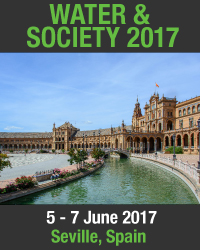Water & Society 2017
4th International Conference on Water & Society
![]()
5 - 7 June 2017
Seville, Spain
Overview

The International Conference on Water and Society took place in Seville organized by the Wessex Institute. It was the 4th in this Series of conferences following previous successful meetings that were held in Las Vegas (USA) in 2011; the New Forest (UK) site of the Wessex Institute in 2013; and La Coruña (Spain) in 2015.
Seville was a very suitable location for the event as the city is surrounded by the Guadalquivir river (“the Great River” in ancient Arabic). It was navigable some centuries ago and the ships going from Spain to America, or returning from the New World, started or finished their voyages from Seville harbour.
The city is more tan 2000 years old and has a distinct personality and a large, well-preserved historical center. The old town contains three world heritage sites: the Minaret of La Giralda, the General Archives of the Indies and the Alcazar Palace. Seville is also home to many convents, churches, palaces, museums and public gardens. Also, on the occasion of the Universal Exhibition in 1992, many modern buildings, including two bridges designed by world renowned civil engineers, were built, ie the Barqueta by J. Arenas and the Alamillo by S. Calatrava.
Conference Opening
The conference was opened by Santiago Hernandez, Professor and Member of the Board of Directors of the Wessex Institute. He welcomed the delegates on behalf of Professor Carlos A. Brebbia and explained the objectives of the meeting, mentioning that the quality of the papers accepted promised a brilliant event. He gave a presentation of the Wessex Institute. narrating the broad range of activities that include research projects on different topics, publication of journals in several scientific fields and also WIT’s time-honored experience in the organization of international conferences, which started more than 30 years ago. These conferences contribute very efficiently in bringing together specialists from academia and industry to present the most up to date achievements for the benefit of the delegates.
The contents of these contributions are then published in books of proceedings and peer-reviewed journals edited by the Institute.
Santiago explained that WIT originated from a research group at Southampton University and is recognised as the creator of the Boundary Elements Method (BEM), a numerical technique initially devoted for engineering analysis but due to the enhancements produced by the Institute can nowadays be used for a vast range of practical applications.
Santiago also explained that WIT welcomes postdoctoral researchers, including those on sabbatical, who can spend an academic year at the Institute working on specific projects, benefitting from the excellent facilities and peaceful surroundings of the Institute.
Invited Presentations
Two invited papers were delivered at the Conference, both dealing with challenging issues.
Professor Rebeca Gonzalez from the Mexican Institute of Water Technology made a presentation entitled “Effects of climate change on water availability for the Usumacinta River Ecological Flow” that described the consecuencies of the climate modifications in the Usumacinta river in Mexico. This river has the second largest basin of the rivers flowing in the Gulf of Mexico, only after the Mississipi river.
Professor Florica Manea from the Politechnica University of Timisoara (Romania) delivered a paper entitled “TiO2-modified zeolite-carbon nonotubes composite electrode for photoelectrodegradation of pentachlorophenol from wáter undefr UV irradiation”. She showed the efficiency of that technique in the treatment of wastewater and commented on its potential for industrial application.
Conference Topics
The papers were divided into a series of sessions under the following headings:
- Water resources contamination
- Water resources management
- Water management and conservation
- Water quality
- Water management
- Water rights
- Urban water management
- Water, sanitation and health
Activities
The delegates had many opportunities to network and discuss problems of common interest during the coffe breaks, lunches and social occasions, in addition to the formal sessions.
The International Scientific Advisory Committee (ISAC) met during the conference to discuss how to improve the meeting in the future. Some new topics to be included were defined and some candidates were nominated as additional members of the ISAC.
Conference Dinner
The Conference Banquet took place at El Palacio Andaluz, a place that combines a restaurant and a flamenco music show. Thus the delegates, in addition to tasting typical Andalucian gastronomy, enjoyed a performance with singers, guitar players and flamenco dancers, comprising of a group of 20 people on stage. The quality of the show and the friendly atmosphere helped to strengthen links among the conference delegates.
Closing of the Conference
The Conference was closed by Prof. Santiago Hernandez, on behalf of Prof. Carlos A. Brebbia, Chairman of the event and Director of the Wessex Institute. He thanked the delegates for their contribution to the success of the meeting.

 Wessex Institute
Wessex Institute